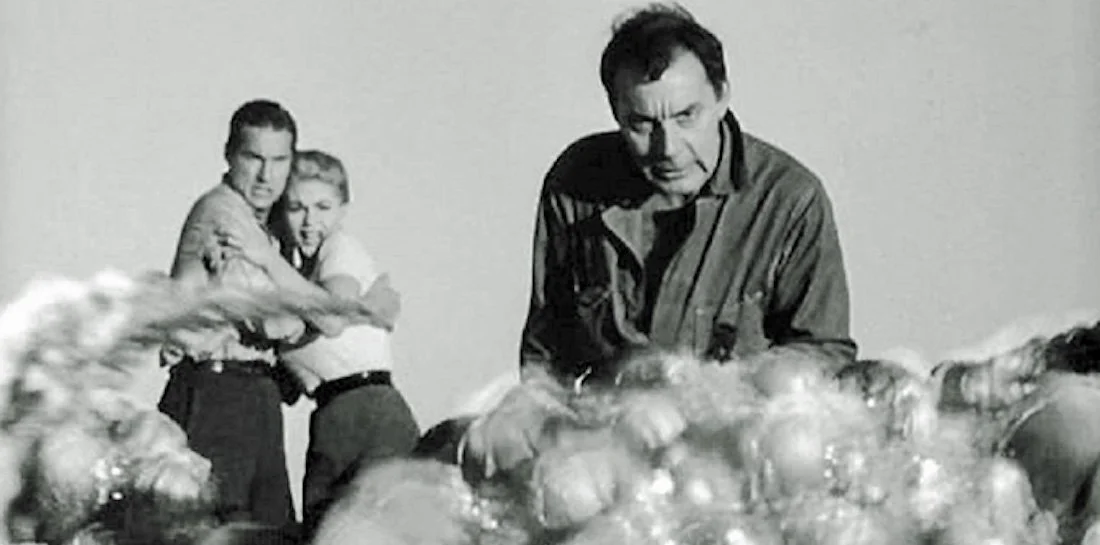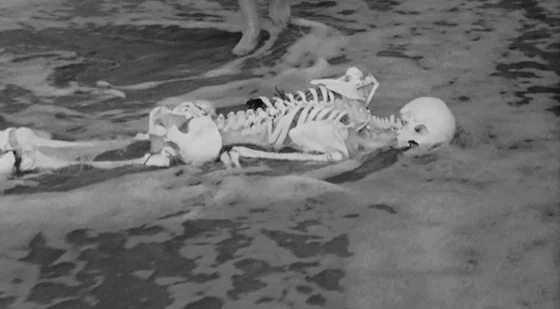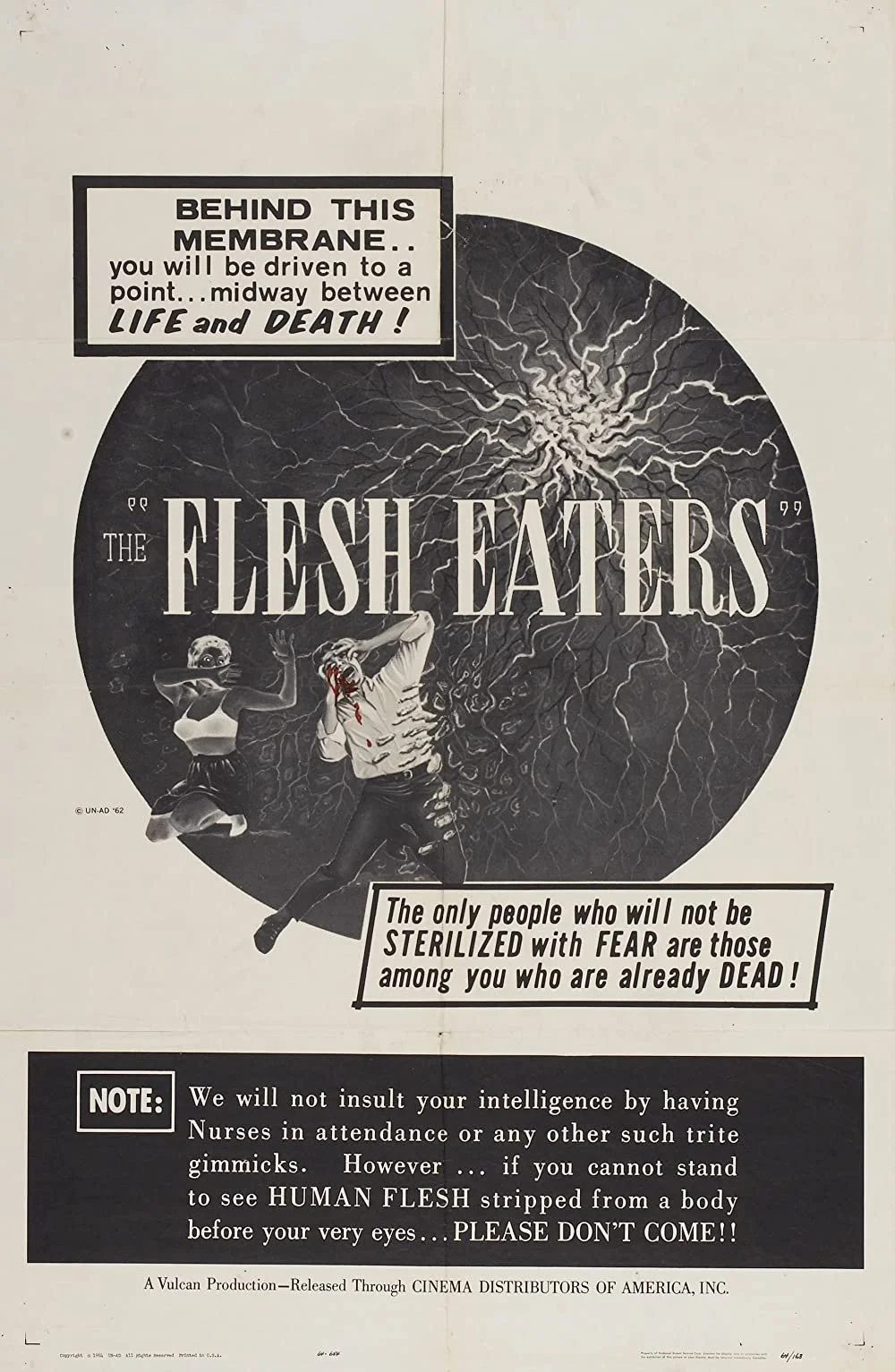THE FLESH EATERS (1964)
I went back and forth with several different films when preparing for this column. Recommending a film has been, and probably always will be, one of my favorite tasks as a film fan. Showing people things they would’ve never considered and getting a positive reaction is a true joy that never fails to make the good-times endorphins hit like a truck. The films I usually write about dive into Shot-on-Video violence and extreme horror, so I thought it would be nice to push the clock back even further, into the very beginnings of splatter and gore in films. Most horror fanatics know about Herschell Gordon Lewis’ BLOOD FEAST (1963), but there’s a film from around the same time that straddles the divide between the 1950s creature feature and the burgeoning gore film: Jack Curtis’ THE FLESH EATERS (1964).
The film follows an airplane pilot named Grant Murdoch (played to chiseled perfection by Byron Sanders), who gets paid to fly alcoholic starlet Laura Winters (Rita Morley giving it her all) and her assistant Jan Letterman (Barbara Wilkin, anchoring the two more dominant personalities) to an important audition. Unfortunately, the plane begins to malfunction as the fuel is not getting through to the engine and they end up setting down at a mysterious abandoned island. In short order, they find a stranded scientist named Peter (a chillingly evil turn from Martin Kosleck) who knows much more than he lets on. While the island doesn’t seem to be too far from civilization, there is a single problem: the surrounding waters are just lousy with flesh-eating microbes!
It’s an excellent creature feature premise that allows the filmmakers to keep the budget low through the sparing use of locations and props. The film follows our erstwhile group of castaways as they attempt to find a way back to society with all their meat intact. Early on, we learn the capabilities of the microbes by the discovery of a fully stripped skeleton and a mass fish die-off that washes up on the shore. We’re treated to our first gore sequence when some splashes onto Grant’s leg, which causes his skin to bleed and begin to melt. Our protagonist is saved from a gooey fate when Peter cuts the flesh from Grant’s shinbone (in extreme close-up) to keep them from spreading further. With our stakes and our threat established, the characters begin to plot, double-cross, and exploit each other. Add another random castaway in the form of beatnik/hippie ne’er-do-well Oscar and the stage is completely set.
The special effects are actually quite nice for the day. The aforementioned shin flaying is primitively effective, with the knife digging deep and tearing the afflicted (latex) skin to help our protagonist. One of the most shocking moments is when Peter contaminates some drink with the microbes and hands it to the unsuspecting Oscar. He begins to convulse shortly thereafter and then his stomach bursts with blood and fluid, a sequence that feels massively at odds with the ‘50s style acting and creature-feature setup. Oh well, Peter gets his in another jarring scene when he gets covered in the flesh eaters, begins to melt then ends his suffering with a gushing shot to the head from his trusty Luger.
But what makes this film so special, beyond an early appearance of the horror-hounds’ much-loved gore? Well, the film is remarkably sturdy in construction. All of the actors give their all and even make some of the goofier dialogue sound fairly natural. Definite shout-out to Oscar talking about his abandoned nuclear physicist path, which grounds his character and pulls him from the comic-relief character mold. The script is provided by comics writer Arnold Drake, who really nails the EC Comics style of dialogue and plotting. The script is also incredibly tight, with each scene serving its purpose and no fluff to bog down the muscular pacing. This leads to a film that’s incredibly captivating, as the violence, creature appearances and human drama ramp up at a satisfying speed that ensures the viewer is never bored. The quick nature of the gore scenes plays into this as well since they hit hard and fast while also driving the plot inevitably forward.
All of this is aided by incredible black-and-white cinematography. Most of the film is shot in deep focus so that we can see multiple actions occurring at once, while never appearing busy. The later shot of Peter watching from a sand dune as Grant and Jan discuss their plans to confront him about his questionable plans and obviously menacing demeanor. Peter watches them like a hawk, visibly taking in their words as they are completely unaware of his presence. This is a very tense scene, and the shot-composition lets us know that they’ll soon be waylaid by the evil doctor. This tense construction of mise-en-scene and use of both foreground and background is really remarkable and helps keep the tension high. The aforementioned scene where Oscar drinks the flesh eaters is made more intense by the use of shadow inside the tent and the shots moving between Oscar’s heartfelt monologue and Peter’s excited eyes as he waits for the microbes to begin eating him from the inside.
Even more impressive is how the film represents the creatures. They are made up of pinprick and double exposures, showing up as blindingly bright swathes and dots on the screen. The haze surrounding them also distorts the landscape and bodies near them, lending them a surreal and other-worldly quality that wouldn’t have been obtainable with more traditional creature appearances. When they latch to flesh, they seem to make the body glow with quick bursts of light like tiny explosions. It makes their presence always noticeable, and the strange way that they’re represented makes them both menacing and almost beautiful.
Later, experiments with electroshocks cause them to fuse into larger and more-traditional creatures, but their appearance is once again bathed in unnatural light and exposure tricks, seeming to give off heat and energy which distorts all imagery around their pulsating bodies. The design itself is Lovecraftian in appearance: a mass of pincers and tentacles surrounding a fleshy eye/nucleus. It makes the final appearance of a large creature very effective, while also not robbing the earlier presentation of its terror and mystique. It’s a very surprising reveal that once again belies the low-budget of the production.
THE FLESH EATERS is truly a fascinating film from a history perspective. It sits right on the line of the genre shift in horror films, while also seeming to pine for the creature features of yore. All the formal elements together form a conglomeration of the past and present, and all of the facets manage to sit comfortably next to each other. Beyond all these musings on genre and film history, it is also a ruthlessly effective film that entertains from start to finish. It’s a film that definitely deserves more recognition. This movie gets a hearty recommendation from me, as both a historical turning point and a great film. What more could you possibly ask for?





